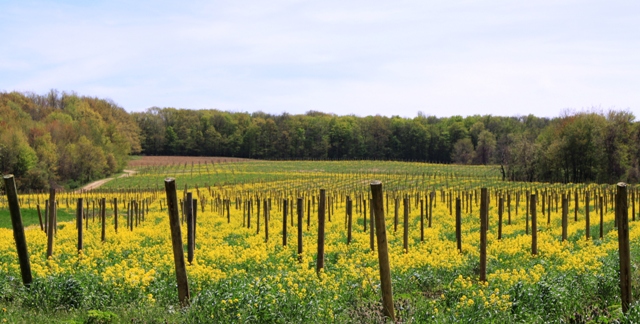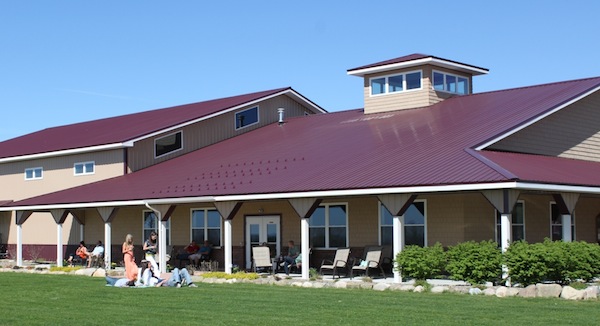Located just two hours north of Pittsburgh in the heart “America’s Grape Belt,” Lake Erie Wine Country spans about 50 miles from Harborcreek, Pa. to Silver Creek, N.Y. The area boasts 30,000 continuous acres of vines, making it the largest grape-growing region east of the Rocky Mountains and the largest producer of Concord grapes in the world. It’s also home to a booming wine business that contributes millions to the local economy through both wine sales and tourism.
As the vines begin to blossom and another busy summer draws near, vintners are seeking new ways to attract visitors.
Healthy competition
While the history of Lake Erie’s wine industry goes back five decades, the Lake Erie Wine Country trail has just recently come into its own. Formerly known as the Chautauqua-Lake Erie Wine Trail, the cohesive, cross-state expanse has provided a haven for chateau-hopping wine enthusiasts since its establishment in 2002. The organization offers access to a number of wineries — including 11 in Pennsylvania — and the list keeps growing: 21 Brix opened in 2011 and Courtyard Wineries opened in 2010.
New blood may seem like new competition to some, but Lake Erie Wine Country Executive Director Julie Pfadt insists that there’s safety in numbers.
“People drive from Pittsburgh to go to 24 wineries, or even 10,” says Pfadt. “They’re not going to drive all this way to go to one.”
The variety of wineries is one of the many reasons to visit Lake Erie Wine Country. Aside from its natural beauty, the trail provides plenty of entertainment, including concerts, shopping and outdoor activities such as biking, boating and fishing.
Lake Erie Wine Country also makes navigating the wineries easier for tourists with perks like the $20 Visit Visa, a “personal passport” that contains discounts and coupons to wineries, restaurants, B&Bs and other attractions.
But, as Pfadt points out, the region still faces some challenges, such as the close proximity to the Niagara Wine Trail in New York and Ashtabula County in Ohio.
“The economy still isn’t that great,” she explains. “We’re competing for tourist dollars just like every other region. And there are other wine trails fairly close, so we have to show off what makes us unique.”
Lake Erie vintners are boosting the effort. Mario Mazza and his father Robert of the Northeast PA winery Mazza Vineyards work with local non-profit organizations, including Lake Erie Wine Country and Visit Erie, to advocate for the region as a vacation destination. Judging from his experience, there are still opportunities to educate the public on its charms.
“I think a lot of people are surprised to find out how much Erie has to offer in terms of different things you can do,” says Mazza. “And they’re all very easy to get to — short distance, short drive, minimal travel.”
Variety is the spice of life
One way Mazza believes they can stand out is by diversifying and experimenting with product. After earning degrees in chemical engineering and enology, he returned to the family business in 2005. Since then, Mazza has used his skills to help develop new creations such as a traditionally Austrian Grüner Veltliner, and Hops and Honey, a lightly carbonated mead made from two varieties of locally grown hops.
Mazza also expanded their brand into another venture, Five & 20 Spirits, a distillery in New York that creates craft whiskey and spirits. Later this year, there are plans to launch a microbrewery.
Diversification is a powerful trend. This year saw the opening of Arundel Cellars & Brewery, a Northeast PA estate surrounded by vineyards and apple orchards. The new addition will not only sell wine, but also craft beer and, later in the year, sparkling cider.
Targeting locavores
Mazza believes that an array of beverages will appeal to a wider demographic, and allow them to target young foodies who are more prone to seek out anything fresh, different and locally-sourced.
“One of the things I’ve noticed since I’ve been back is the general interest in regional and local wines,” says Mazza. “There’s a lot of talk about the ability to market to Millennials and their interest in trying new products.”
In addition to the income generated from tourism, the Mazzas sell more than half of their product in the wholesale market, including private label brands. One of their customers is the Wooden Angel, a fine dining establishment located in Beaver, Pa. Mazza Vineyards began bottling house wines for owner Alex Sebastian 35 years ago and their continued relationship reflects the public's increasing interest in local or regional wines.
“Requests are slow, but we sell more of their wines than any of the other 400 wines on our list,” notes Sebastian, citing the popularity of the Wooden Angel's Mazza-produced Country Red, Vidal Blanc and Noiret.
Local and state governments are also recognizing the economic possibilities of wine tourism. While many of the new initiatives are on the New York side — including a $6 million program dedicated to raising the profile of wine producers — Pfadt points out that any promotion will benefit both states as one big wine region. She also credits Erie County for using the Hotel Occupancy Tax to procure funds for Lake Erie Wine Country. But while funding always presents a challenge, she believes that the region practically sells itself.
“We’ve got a lot of refurbishing going on, and new wineries and new events,” says Pfadt. “It’s very dynamic and ever-changing, and it’s just beautiful here.”





